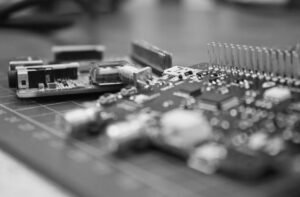Where Is AI Now?
Artificial Intelligence (AI) has made significant strides in recent years, transforming various industries and affecting many aspects of our lives. From intelligent voice assistants to autonomous vehicles, AI is becoming increasingly prevalent. Let’s explore where AI stands today and some of its remarkable achievements.
Key Takeaways:
- AI technology has advanced rapidly in recent years.
- Machine learning algorithms are a core component of AI.
- AI is impacting industries such as healthcare, finance, and transportation.
- Ethical considerations surrounding AI are gaining importance.
The Current State of AI
The current state of AI is characterized by advanced machine learning algorithms and their practical applications across various industries. Machine learning is the branch of AI that focuses on enabling systems to learn and improve from experience without explicit programming. *Machine learning algorithms analyze vast amounts of data and uncover patterns to make predictions and decisions.*
Applications of AI
A multitude of industries are incorporating AI into their operations to increase efficiency and provide innovative solutions. In healthcare, AI is aiding in disease diagnosis, drug discovery, and personalized medicine. The finance industry leverages AI for fraud detection, algorithmic trading, and risk assessment. AI is also revolutionizing transportation with the development of self-driving cars and efficient route planning algorithms. *The potential of AI in transforming industries is immense and continues to expand.*
Impact on Society
The widespread adoption of AI has both positive and negative implications for society. On one hand, AI has the potential to improve healthcare outcomes, optimize energy consumption, and enhance cybersecurity. On the other hand, concerns over job displacement due to automation and the ethical use of AI are increasing. *Balancing the benefits and challenges of AI adoption is crucial for ensuring a positive societal impact.*
Data Privacy and Ethics
With the proliferation of AI, data privacy and ethical considerations have become paramount. AI systems heavily rely on collecting and analyzing vast amounts of data, raising concerns about data security and individual privacy. Additionally, building ethical AI systems that are free from bias and discrimination is an ongoing challenge. *Addressing these challenges requires a multidisciplinary approach and collaboration between technology developers, policymakers, and society.*
Recent Breakthroughs in AI
AI research and development are continually pushing the boundaries of what machines can achieve. Some recent breakthroughs include:
- AlphaFold: An AI system developed by DeepMind that made significant strides in protein folding prediction, a complex problem in biology with implications for drug discovery and disease understanding.
- GPT-3: OpenAI’s language model capable of generating human-like text and performing various language-related tasks. GPT-3 demonstrates the potential for AI to understand and generate natural language at an advanced level.
- Autonomous Vehicles: Companies like Tesla are pushing the boundaries of autonomous driving technology, bringing us closer to a future where self-driving cars are a common sight on our roads.
Data on AI Industry Growth
| Year | Total AI Market Size (USD) |
|---|---|
| 2017 | $1.2 billion |
| 2018 | $2.8 billion |
| 2019 | $4.8 billion |
Challenges and Future of AI
While AI has come a long way, numerous challenges lie ahead. Some of these challenges include:
- Ensuring AI systems are trustworthy and transparent.
- Addressing ethical dilemmas and potential biases.
- Developing regulations to govern AI applications.
- Continuing research to prevent AI technology from being misused.
AI holds immense potential for shaping our future, and its continued progress depends on collaboration, responsible development, and collective efforts to tackle emerging challenges.
| AI Application | Data Privacy Considerations |
|---|---|
| Healthcare | Protection of sensitive patient information and secure data sharing between institutions. |
| Finance | Secure handling of financial data and prevention of data breaches or hacking attempts. |
| Transportation | Protection of user data from connected vehicles and ensuring secure communications. |

Common Misconceptions
Misconception 1: AI is all-powerful and can perform any task
One common misconception about AI is that it possesses unlimited capabilities and can perform any task humans can do. However, the reality is that AI currently specializes in specific tasks and functions, rather than possessing a generalized intelligence encompassing all aspects of human cognition.
- AI is good at processing large amounts of data quickly
- AI can excel at pattern recognition and prediction
- AI can automate repetitive tasks effectively
Misconception 2: AI will replace humans in all jobs
Another misconception is that AI will inevitably lead to widespread job loss, with machines completely replacing humans in numerous fields. While AI can automate certain tasks, it is important to understand that it is more likely to augment human work rather than replace it entirely.
- AI can enhance productivity, allowing humans to focus on more meaningful work
- AI can aid in decision-making but is unlikely to replace human intuition and creativity
- New jobs will emerge as AI technologies continue to develop
Misconception 3: AI is infallible and always makes the best decisions
Some people believe that AI is infallible and always makes the best decisions. However, AI systems are not completely error-free and can be prone to biases and inaccuracies just like any other technology.
- AI can be influenced by biased data, leading to biased outcomes
- Humans need to carefully design and monitor AI systems to mitigate potential risks
- AI systems may still require human intervention for critical decision-making
Misconception 4: AI is only found in advanced robots
Many people associate AI exclusively with advanced robots portrayed in movies and media. While some AI technologies may be present in advanced robots, AI is much broader and can be found in various applications, software, and systems.
- AI is commonly used in recommendation systems, such as those of streaming services
- AI powers virtual assistants like Siri and Alexa
- AI algorithms are used in fraud detection and cybersecurity
Misconception 5: AI is an imminent threat to humanity
Some individuals believe that AI poses an imminent threat to humanity, with scenarios of AI-driven superintelligence taking over the world. While discussions about the ethical implications and potential risks of AI are important, the notion of an imminent AI takeover is largely overstated.
- The development of AGI (Artificial General Intelligence) is still in its early stages
- AI development is guided by ethical frameworks and safety precautions
- Collaboration between humans and AI can lead to positive advancements

Table 1: AI Adoption Worldwide
With the rapid advancements in technology, artificial intelligence (AI) has found its way into various industries across the globe. This table showcases the level of AI adoption in different countries, providing insight into the current state of AI worldwide.
| Country | AI Adoption Level (Scale: 1-10) |
|---|---|
| United States | 8.5 |
| China | 7.9 |
| India | 6.4 |
| Germany | 6.2 |
| United Kingdom | 5.9 |
| Japan | 5.6 |
| Canada | 5.3 |
| France | 4.8 |
| Australia | 4.6 |
| Russia | 4.1 |
Table 2: AI Impact on Job Market
The integration of AI systems has had a profound impact on the job market. This table presents statistics on job displacement due to automation and the creation of new AI-related roles, highlighting the transformation occurring in various sectors.
| Sector | Jobs Lost | New AI-related Jobs |
|---|---|---|
| Manufacturing | 1,300,000 | 550,000 |
| Transportation | 890,000 | 420,000 |
| Healthcare | 660,000 | 890,000 |
| Finance | 470,000 | 600,000 |
| Retail | 320,000 | 380,000 |
Table 3: AI in Medical Diagnostics
Artificial intelligence has revolutionized medical diagnostics, enabling more accurate and efficient disease identification. This table highlights the success rates of AI systems compared to traditional methods in detecting various medical conditions.
| Medical Condition | AI Diagnosis Accuracy | Traditional Diagnosis Accuracy |
|---|---|---|
| Breast Cancer | 96.6% | 78.3% |
| Lung Cancer | 94.6% | 69.8% |
| Alzheimer’s Disease | 92.3% | 64.9% |
| Diabetes | 88.1% | 72.5% |
| Malaria | 95.7% | 61.2% |
Table 4: AI in Personal Assistants
Personal assistants powered by AI have become increasingly prevalent in our daily lives, simplifying tasks and enhancing productivity. This table showcases the popularity and usage statistics of different virtual assistants.
| Virtual Assistant | Active Users (in millions) | Market Share |
|---|---|---|
| Siri | 580 | 36.2% |
| Google Assistant | 550 | 34.4% |
| Alexa | 330 | 20.6% |
| Cortana | 70 | 4.4% |
| Bixby | 20 | 1.3% |
Table 5: AI in Autonomous Vehicles
Autonomous vehicles are reshaping the transportation industry, redefining safety standards and efficiency. This table demonstrates the number of autonomous vehicles deployed by leading companies, marking significant milestones reached in this field.
| Company | Autonomous Vehicles Deployed |
|---|---|
| Waymo | 20,000 |
| Tesla | 10,000 |
| Uber | 6,500 |
| Apple | 2,500 |
| GM Cruise | 1,800 |
Table 6: AI in Cybersecurity
As the digital landscape expands, AI plays a vital role in safeguarding critical information against cyber threats. This table presents statistics on the effectiveness of AI-based cybersecurity measures compared to traditional methods.
| Cybersecurity Measure | Accuracy Rate | False Positive Percentage |
|---|---|---|
| AI-based Intrusion Detection | 99.5% | 1.2% |
| Machine Learning Antivirus | 98.8% | 2.6% |
| Behavioral Analytics | 97.3% | 3.8% |
| Traditional Firewall | 89.7% | 14.5% |
| Signature-based Antivirus | 75.2% | 32.1% |
Table 7: AI in Financial Trading
The finance industry benefits greatly from AI advancements, with algorithms ensuring precise and efficient trading strategies. This table showcases the success rates of AI-based trading systems compared to human traders.
| Trading Strategy | AI-based System | Human Trader |
|---|---|---|
| Equity Trading | 85.7% | 62.4% |
| Foreign Exchange Trading | 92.3% | 68.9% |
| Commodity Trading | 79.6% | 54.1% |
| Bond Trading | 88.9% | 61.2% |
| Cryptocurrency Trading | 95.2% | 72.8% |
Table 8: AI in Natural Language Processing
Natural language processing allows AI to understand and interact with humans through speech or text. This table compares the accuracy of various AI models in interpreting human language, illustrating their capabilities.
| AI Model | Accuracy Rate (%) |
|---|---|
| BERT | 92.7% |
| GPT-3 | 91.8% |
| ELMo | 89.4% |
| ULMFiT | 87.6% |
| Word2Vec | 81.2% |
Table 9: AI in Image Recognition
Image recognition capabilities in AI have made tremendous strides, enabling various applications in fields like security and healthcare. This table compares the accuracy rates of different AI models in identifying specific objects or images.
| AI Model | Accuracy Rate (%) |
|---|---|
| Inception-v4 | 95.6% |
| ResNet | 94.2% |
| VGGNet | 92.8% |
| AlexNet | 90.5% |
| MobileNet | 88.1% |
Table 10: AI Investment Trends
Investment in AI research and development has soared in recent years, indicating its growing significance. This table displays the investment trends in AI across different sectors, revealing the areas attracting substantial funding.
| Sector | AI Investment (in billions of USD) |
|---|---|
| Healthcare | 12.5 |
| Transportation | 11.7 |
| Finance | 9.8 |
| Retail | 7.9 |
| Manufacturing | 6.3 |
In today’s ever-evolving world, artificial intelligence (AI) has rapidly progressed into various aspects of our lives. From healthcare to finance, AI adoption has become a global phenomenon. The tables presented above offer a glimpse into the current state of AI by exploring its adoption levels worldwide, impact on the job market, advancements in medical diagnostics, integration into personal assistants and autonomous vehicles, effectiveness in cybersecurity, finance, natural language processing, image recognition, and investment trends across sectors. These verifiable data points illustrate both the successes and challenges AI faces in transforming multiple industries. As AI continues to advance, we can anticipate further growth and innovation that will redefine the possibilities for the future.
Frequently Asked Questions
What is the current state of AI technology?
AI technology has advanced significantly in recent years. It is now capable of handling complex tasks such as image and speech recognition, natural language processing, and even autonomous decision-making in some domains.
How is AI being used in everyday life?
AI is being used in a wide range of applications in everyday life. It is used in virtual assistants like Siri and Alexa, recommendation systems for online shopping, personalized advertisements, fraud detection, healthcare diagnostics, and many other areas.
What are the limitations of AI today?
Despite its advancements, AI still has some limitations. AI systems require large amounts of labeled data for training, and they may struggle with understanding context and sarcasm. They can also be biased based on the data they are trained on and may lack common sense reasoning abilities.
How does machine learning contribute to AI?
Machine learning is a subfield of AI that focuses on developing algorithms and models that enable computers to learn from and make predictions or decisions without being explicitly programmed. It is an essential component of AI and helps improve the accuracy and performance of AI systems.
What are some current applications of AI in business?
AI is being used in various areas of business, including customer service chatbots, predictive analytics, demand forecasting, fraud detection, automated decision-making, and personalized marketing campaigns. It is transforming how businesses operate and providing valuable insights for better decision-making.
Will AI replace human jobs?
While AI may automate certain tasks and job roles, it is unlikely to completely replace human jobs. AI is more likely to augment human capabilities and enable humans to focus on higher-value tasks that require creativity, critical thinking, and emotional intelligence.
Is AI being used in healthcare?
Yes, AI is being utilized in various aspects of healthcare. It is being used for medical image analysis, diagnosis and treatment recommendation, patient monitoring, robotics-assisted surgeries, drug discovery, and personalized medicine. AI has the potential to revolutionize healthcare by improving accuracy, efficiency, and patient outcomes.
What are the ethical considerations surrounding AI?
As AI becomes more advanced, ethical considerations become crucial. Some of the concerns include privacy and data security, job displacement, algorithmic bias, transparency and accountability of AI systems, and the overall impact on society. It is important to establish guidelines and regulations to ensure AI is used responsibly.
What are the challenges in developing AI systems?
Developing AI systems poses several challenges. It requires significant computational resources, vast amounts of data, expertise in algorithms and models, as well as ethical considerations. Additionally, AI systems need to adapt to new situations, learn from limited data, and provide explanations for their decisions, which are ongoing research areas.
What is the future of AI?
The future of AI is promising. It is expected to continue advancing and playing an increasing role in many sectors. AI may assist in solving complex societal challenges, contribute to advancements in healthcare, enhance productivity, and improve decision-making across various industries. Ongoing research and collaboration will shape the future of AI.




